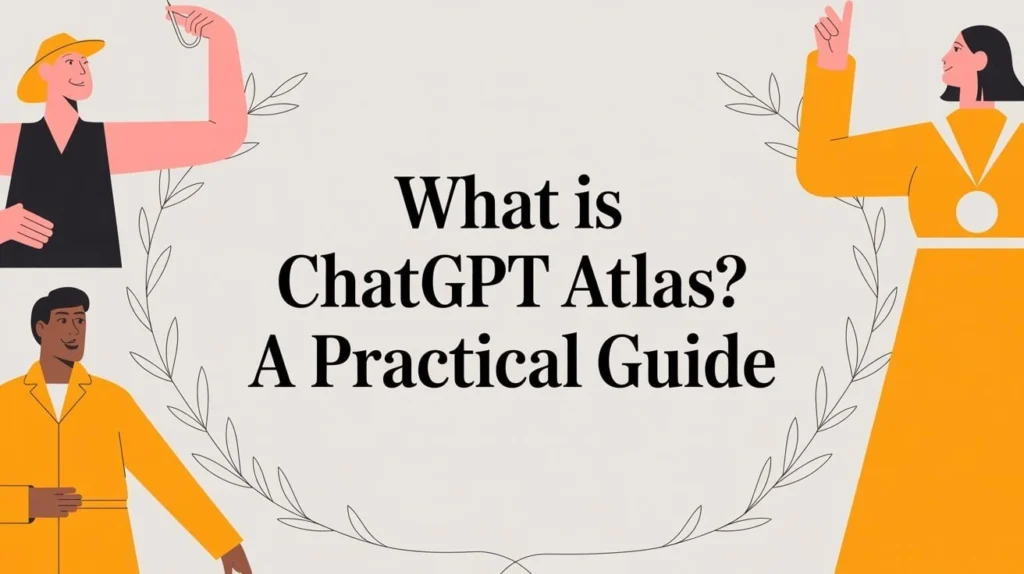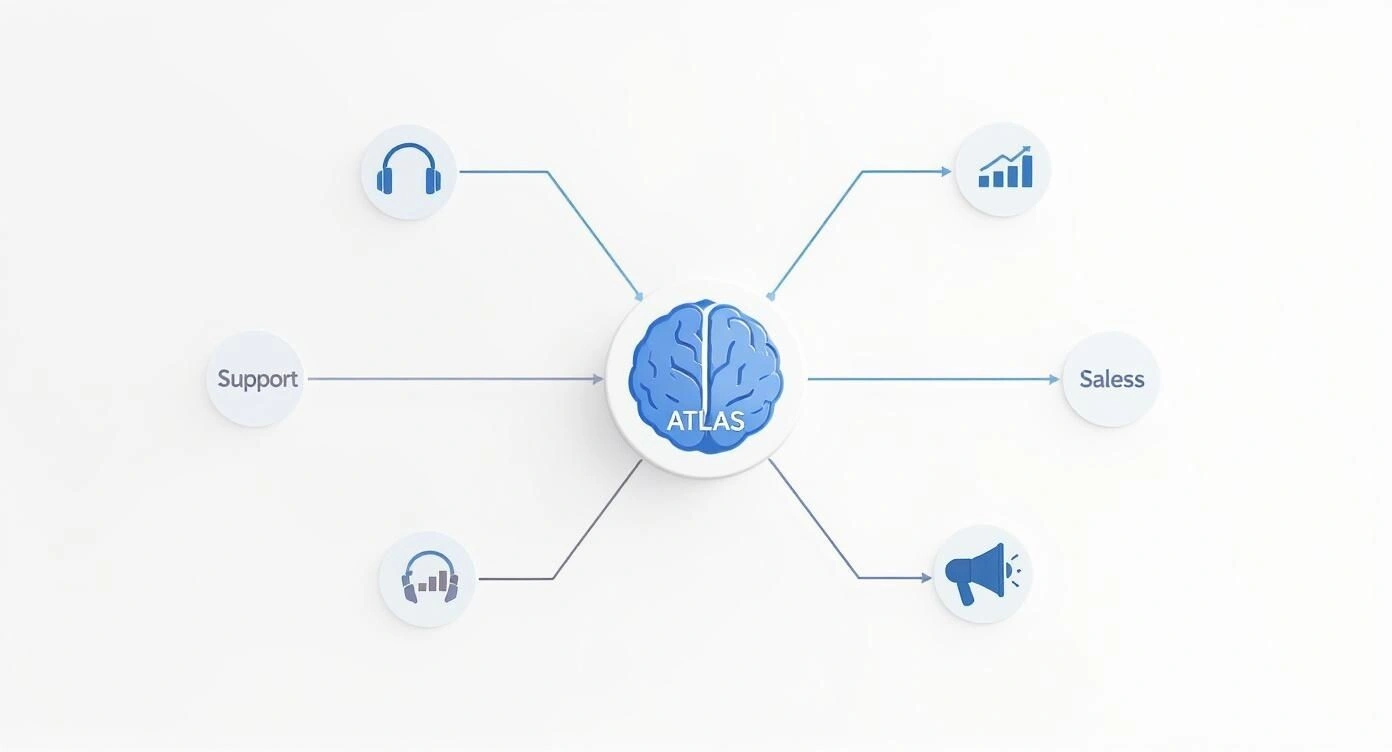Introducing ChatGPT Atlas: A Guide for the Rest of Us
Feeling lost with the new ChatGPT Atlas? This guide breaks down what it is, how it works, and what it means for your business in simple, practical terms.

So, you’ve probably seen the news about OpenAI’s latest thing: ChatGPT Atlas. And if you’re anything like me, your first thought might have been, “Oh great, another AI tool I need to figure out.” But hang on. This one’s a bit different. It’s not just another update to the chatbot we’ve all been tinkering with. This feels… bigger. And way more practical for day-to-day work life.
So, What Exactly Is ChatGPT Atlas?
Let’s just get straight to it. Think about all your company’s stuff for a second. Seriously. You’ve got documents living in SharePoint, a whole universe of customer stories buried in Salesforce, and project updates scattered across a million different Slack channels. It’s an absolute mess, isn’t it? A digital garage full of boxes with no labels.
We’ve all had that moment. That sinking feeling in your stomach when you know, you know, a file exists somewhere, but you have no earthly idea where to even start looking. It’s infuriating.
ChatGPT Atlas is meant to be the super-organised friend who comes over and helps you clean out that garage.

It’s less of a chatbot you have a conversation with and more like a central brain for your entire organisation. Its whole job is to securely plug into all those different systems, understand what’s in them, and create one single, unified place to find everything.
It’s About Finding, Not Just Answering
Here’s where it gets interesting. This isn’t just about asking a question and getting a nice, tidy paragraph back. It’s about being able to ask a real, human question like, “Where’s the final sales report for Q3 in the APAC region?” and having Atlas just… find it. The actual file. It doesn’t care if it’s buried in some shared drive from 2021 or attached to an email you forgot about.
It’s built to solve that one chronic, nagging problem: ‘I know we have this somewhere…’
And this shift from a fun conversational tool to a serious knowledge finder is happening for a reason. We’re seeing a huge surge in AI adoption right here in Australia. It’s not a novelty anymore. A recent report from OpenAI reckons that this kind of AI could add a massive A$115 billion to our economy each year by 2030. That’s a wild number, and it shows just how deeply this tech is weaving itself into how we work. If you’re a numbers person, you can get into the details in the OpenAI economic blueprint for Australia.
This little table helps break down the change in thinking.
ChatGPT Atlas at a Glance
| Feature | What It Means For You |
|---|---|
| Data Connectivity | It’s not a lonely chatbot. Atlas actually plugs into the systems you already use, like your CRM and cloud storage. |
| Knowledge Indexing | It doesn’t just chat. It builds a smart map of all your company’s knowledge so you can find anything. |
| Enterprise-Grade Security | It’s built for business, with proper security so your data stays your data. No ifs, no buts. |
| Action-Oriented AI | It does more than just answer questions. It can actually do things, like find a specific file or pull data from a few places at once. |
Really, Atlas is all about making the information you already have genuinely useful. Not just stored.
What This Means For Your Organisation
So, why does any of this actually matter? Well, because information is useless if you can’t find it when you need it. This whole thing changes how we interact with our own company’s knowledge.
You stop searching. You start asking. Simple as that. You stop clicking through endless folders and you just get the answer you need, or the exact document you were looking for. This is the big idea, because everything else we’re about to talk about… it all builds on this one simple, powerful change.
The big promise of ChatGPT Atlas is to turn your company’s chaotic digital attic into a single, smart, and instantly useful source of truth.
The Core Features That Power Atlas
Okay, so we’ve got the main idea: ChatGPT Atlas is like a central brain for your company. But what’s really going on inside? What are the actual bits of tech that make it so different from the ChatGPT you might use to write a birthday card?
Let’s pop the bonnet and have a look. It’s not as scary as it sounds, I promise.

AI Agents That Actually Do Things
First up, you’ve got these things called AI Agents. You’ll hear this term a lot, so let’s just nail it down. An agent isn’t just a fancy search bar. It’s more like a super-capable digital assistant you can actually give real jobs to. Multi-step jobs.
Instead of just finding info for you, an agent can act on that info across different systems.
For example, you could say, “Find the final Q3 marketing deck and email it to Sarah in the sales team.” A normal search might find the deck… maybe. An Atlas agent is designed to understand the whole request. Find the file, figure out who ‘Sarah in sales’ is from your contacts, and then actually send the email.
It’s a small change in wording but a massive leap in what it can do. The AI stops being a passive book you read and becomes an active helper in your day. This is where you start getting real time back.
Intelligent Knowledge Indexing
Next up is intelligent knowledge indexing. Honestly, this is the magic bit. It’s one thing to connect to all your files, but it’s something else entirely to make all of that information findable in a way that makes sense.
We’ve all been there. You spend a whole morning digging through three different cloud drives and a swamp of old emails, hunting for that one client contract you know you saw last month. It’s such a waste of energy.
Atlas is built to kill that specific headache. When it connects to your systems, it doesn’t just see a list of file names. It actually reads and understands the stuff inside them. It creates this rich, connected map of your company’s collective brain.
This means when you ask for “agreements with Client X about the Melbourne project,” Atlas isn’t just looking for those words in a filename. It understands the relationships between the client, the project, and the stuff inside the document. It gives you what you actually need.
Seamless Data Integration
And finally, how does it all link up? Through data integration. The real power here comes from its ability to plug into the tools your team already uses every single day. We’re talking about the big ones:
- CRM Systems like Salesforce or HubSpot.
- Cloud Storage like Google Drive, SharePoint, and Dropbox.
- Project Management Tools like Jira or Asana.
- Communication Platforms like Slack.
This isn’t about throwing out all your current tech. That would be a nightmare. No one wants that. Instead, Atlas just sits on top of everything like a smart layer, tying it all together without forcing you to move a single file. For anyone curious about how these kinds of connections work under the hood, checking out something like the OpenAI Connector Registry can give you a good idea.
This focus on making AI genuinely useful isn’t a surprise, especially here in Australia. Recent data shows we’ve gone absolutely nuts for this stuff. Aussies have made over 38 million searches with tools like ChatGPT, which works out to be 1.42 searches for every person in the country. That’s more than anywhere else in the world. We’re clearly hungry for it, and you can see more on these ChatGPT usage statistics in Australia.
Together, these three things… the agents, the smart indexing, and the easy connections… are what give ChatGPT Atlas its power. They turn it from a cool idea into something you can actually use.
How Your Business Can Use ChatGPT Atlas
Right, enough with the theory. Let’s talk about what this actually looks like on a busy Tuesday afternoon. How does ChatGPT Atlas actually help a real, living, breathing Australian business get stuff done?
Let’s step away from the tech talk and just walk through a few real-world moments. This is where it stops being an interesting concept and starts becoming a seriously handy tool.
Revolutionising Customer Support
Okay, imagine you’re on the customer support team. A call comes in, and the customer sounds a bit stressed already. What happens now? You probably have to open your CRM, then check the billing system, then maybe even dig through an old shared drive to find their original contract. It’s a clumsy juggle between three or four different screens.
With ChatGPT Atlas, your support person just types a simple question: “Show me the full history for customer ID 12345.”
Boom. Instead of a frantic treasure hunt, Atlas pulls it all together instantly. It summarises their purchase history from the CRM, flags any unpaid invoices from the finance software, and even finds notes from their last support call. All of it, right there in one simple summary.
What used to be a five-minute scramble across three systems now takes about ten seconds. That’s not just a tiny bit more efficient; it’s a completely different and better experience for the customer.
Empowering Your Sales Team
Now, picture your sales crew. They’re on the phone with a great lead in Melbourne from the retail industry. The lead asks for an example of how you’ve helped a similar business before.
The old way? Your salesperson has to say, “Great question, I’ll find that and send it over,” and then spend the next hour digging through a messy marketing folder for the right case study. The moment is lost.
The Atlas way? They just ask, “Find me the best case study for a retail client in Melbourne.” Instantly, the AI finds the perfect document and brings it up. They can email it to the lead while they’re still on the phone. The conversation just keeps flowing. It’s like turning your entire archive of past work into an instant sales weapon.
Here’s a little peek from OpenAI that shows how this is meant to feel really natural and smooth right inside the browser.
You can see the goal is to make these powerful searches feel as easy as sending a message, weaving the AI’s smarts directly into how you already work.
Making Marketing Data Make Sense
Marketing teams are basically drowning in data. You’ve got Google Analytics over here, social media stats over there, and CRM data in a completely different place. Trying to pull all that together for a monthly report is a soul-destroying copy-and-paste job.
Imagine being able to just ask ChatGPT Atlas, “Analyse our campaign performance for last month using data from Google Analytics, Facebook Ads, and our CRM. Then draft a report summarising the key trends and our return on investment.”
It just… connects the dots for you. It can see that a spike in website traffic came from a specific ad campaign, then cross-reference that with sales data in the CRM to show you which leads actually bought something. This is a real-world example of a technique called Retrieval-Augmented Generation (RAG). It’s a fancy term, but all it means is the AI uses your actual, real-time data to give you answers. If you want to get nerdy about the mechanics, you can learn more about what RAG is and how it all works.
These examples aren’t some sci-fi dream. They tackle the real, boring, time-sucking problems that slow businesses down every single day. That’s what ChatGPT Atlas seems designed to do: turn your scattered mess of information into a powerful engine for getting things done.
Integrating Atlas With Your Existing Systems
Okay, let’s talk about the elephant in the room. You hear about some powerful new tech, and there’s always that little voice in your head going… “Yeah, but how much of a pain will it be to connect this to everything we already use?”
We’ve all been burned before, haven’t we? The promise of ‘seamless integration’ that turns into months of technical headaches, custom code, and endless meetings. It’s a totally fair question. You’re already juggling a dozen different software tools, and the last thing you need is another complicated one.
The good news is, OpenAI seems to have really thought this part through. They get that for ChatGPT Atlas to be useful, it can’t be off on its own island. It has to become part of your workflow, not blow it up.
Starting With Simple Connections
The approach seems to be all about starting simple. For the most common tools that pretty much everyone uses—you know, things like Salesforce, Google Workspace, and Microsoft 365—they’ve got pre-built connectors.
Think of them like ready-made power adaptors. You’re not trying to rewire the plug yourself; you’re just clicking a few things together. This is a huge deal. It means you can get a quick ‘win’ on the board without needing to book a developer for weeks. You could connect Atlas to your company’s shared drive, for example, and start seeing the benefits of its smart search almost immediately.
This lets you dip your toe in the water and prove that it’s useful before you dive into a massive, company-wide project.
When You Need a Custom Fit
Of course, no two businesses are the same. You’ve probably got some unique, home-grown systems that are the lifeblood of your operation. This is where things usually get complicated. For those situations, Atlas has a proper API (that’s an Application Programming Interface).
Don’t let the acronym freak you out. An API is just a secure doorway that lets different software programs talk to each other. Yes, this part needs a bit of technical skill to set up, but it gives you the freedom to connect Atlas to literally anything you have. It’s the path you take for your own special databases or custom-built tools.
This little graphic helps you picture how Atlas can become the central brain for different departments, pulling info from all their different tools.

The key thing to see here is that Atlas isn’t just one thing. It’s a central hub that can serve the unique needs of each team by tapping into the tools they rely on most.
The Big Strategic Question: Pilot or Full Rollout?
So, where do you start? This isn’t really a technical question. It’s more about strategy. I’ve seen these kinds of projects go both ways, and there are good and bad points to each.
- The Pilot Project: You pick one department. Let’s say, customer support. You connect Atlas just to their main tools. This is a low-risk way to learn, iron out any issues, and build a great success story for the rest of the company.
- The Broader Rollout: You go bigger from the start, connecting Atlas to a few core systems everyone uses, like your main document storage. This gets value to more people faster, but it takes more planning.
If you want my two cents? Start small. Find one painful problem in one team. Solve it with a pilot. The excitement from that team will do more to convince everyone else than any PowerPoint presentation you could ever make.
The whole point is to make this feel manageable. You build momentum. You start with the easy connections and then grow from there as you prove how valuable ChatGPT Atlas is to your business. It’s a journey, not a switch you flip overnight.
Understanding Security and Data Privacy
Okay, let’s tackle the big one. The one that keeps business owners and IT managers awake at night. Security.
You’re thinking about giving an AI access to basically all of your company’s sensitive information. Your financial reports, your customer lists, your secret plans for world domination… everything. It’s completely normal to feel a bit queasy just thinking about it. Actually, if you weren’t worried, I’d be a bit concerned.
So, let’s talk straight about how OpenAI is handling security and data privacy with ChatGPT Atlas. This isn’t a small detail; for a lot of businesses, this is the whole story.

The first, and most important, thing to get straight is this: according to OpenAI, your business data is not used to train their public models. Your information is yours. Full stop. It’s used to provide the service to you, and only you.
That’s a hard line in the sand, and it’s a crucial one. It means your company secrets aren’t going to accidentally teach the global ChatGPT model how your business works.
Keeping Your Data Under Lock and Key
So, if your data isn’t being used for training, how is it kept safe? The approach is built on a few key ideas that any serious business tool should have.
It all starts with end-to-end encryption. This is non-negotiable. It means your data is scrambled and protected both when it’s moving between your systems and Atlas (in transit) and when it’s just sitting there being stored (at rest). Think of it like putting your valuables in a coded lockbox that only you have the key to.
But that’s only one piece of the puzzle. What about who inside your own company can see what?
This is where granular access controls come in. You can’t have the new marketing intern suddenly being able to see everyone’s salary. That would be a catastrophe. Atlas is designed to respect your existing permissions. If someone doesn’t have access to a certain SharePoint folder in your normal setup, they won’t be able to get to it through Atlas either.
You’re still in charge of who sees what. The AI simply inherits the rules you’ve already set up. It’s a smart layer on top of your security, not a back door to get around it.
This level of control is so important. It’s not just about stopping hackers; it’s about managing your own data responsibly. Getting this right is a huge topic on its own, and if you want to dig deeper, exploring strategies for a solid AI governance plan is a really smart move.
The Australian Context: Data Sovereignty
For any Aussie business, especially if you’re in an area like finance or health, the conversation gets even more specific. We have strict rules about data privacy and, sometimes, where that data is physically stored. This is often called data sovereignty.
OpenAI has said that Atlas is built to meet these kinds of serious enterprise needs. While the specifics on Australian data centres are still part of the bigger picture, the whole system is designed to meet tough compliance standards like SOC 2. This shows they’re committed to the kind of security that bigger, regulated businesses have to have.
At the end of the day, looking at ChatGPT Atlas isn’t just about the cool features. It’s about being able to look your team in the eye and say, with confidence, that your most valuable asset—your data—is safe. It seems like OpenAI gets that, and they’ve made security a core part of the design, not just an optional extra.
Your First Steps With ChatGPT Atlas
Okay, so the potential of ChatGPT Atlas is probably starting to click. It’s interesting, maybe even a little bit exciting. But where on earth do you begin? It’s one thing to understand an idea, but it’s another thing entirely to turn that into a real plan. The gap between “that’s cool” and actually rolling it out can feel massive.
Don’t panic. You don’t have to do everything at once. The best way to start is with a small, focused project that can give you a clear, obvious win. Think of this as your practical map to go from just thinking about Atlas to actually doing something with it.
Identify a Pilot Project
First thing’s first: find the perfect little test case. Forget about a huge, company-wide rollout for now. Think small. Think specific. Think about a nagging, annoying problem that everyone complains about over coffee.
A great place to start is often with your internal knowledge base. You know the one I mean. The company wiki or shared drive that was meant to be the ‘single source of truth’ but is now a sprawling, out-of-date mess that nobody trusts.
Making that resource instantly and smartly searchable is a brilliant first project. It’s:
- Low-Risk: You’re not messing around with critical customer systems.
- High-Impact: Solving the “I can never find anything” problem makes everyone’s day just a little bit better.
- Easy to Measure: You can actually track how much less time people spend hunting for information.
The goal is simple: pick a battle you can definitely win. This creates a powerful success story inside the company that does the selling for you.
Build Your Business Case
Once you have a pilot project in mind, you need to get your bosses on board. And to do that, you need to speak their language. That means you’ve got to stop talking about the cool tech and start talking about real, measurable business results.
You need to build a solid business case based on return on investment (ROI).
Start by putting a number on the pain. For instance, if your team wastes hours every week looking for documents, calculate that lost time. If 10 people waste 2 hours a week, that’s over 1,000 hours of lost productivity in a year. Suddenly, the problem has a dollar value.
Your business case shouldn’t be about buying a new AI tool. It should be about solving a specific business problem. The tool is just the solution. Frame it in terms of hours saved, faster replies to customers, or better decisions.
This focus on real value is everything. There’s a reason Aussies have jumped on tools like ChatGPT. It’s because they see practical uses. While we make up about 1.8% of the world’s ChatGPT traffic, our enthusiasm is off the charts. Over 90% of Australian users say they get good results from it. They’re using it for everything from business planning to research, which shows a clear demand for tools that just make work easier. You can find more fascinating details in these ChatGPT statistics and insights.
A Simple Plan to Get Started
So, what does this look like in a simple, step-by-step plan?
- Find the Pain: Go talk to your teams. Find one specific, recurring information headache.
- Define the Pilot: Scope out a small, contained project to solve that one problem (e.g., “Make our internal marketing drive searchable”).
- Calculate the ROI: Put numbers to the problem. Estimate the time saved or the efficiency you’ll gain.
- Present the Case: Pitch your pilot project to the decision-makers, focusing on the business results, not just the tech.
This is your blueprint. It’s a structured, low-risk way to explore what ChatGPT Atlas can do for your organisation. It moves you past the hype and into a real, practical evaluation, letting you prove the value one clear, successful step at a time.
Frequently Asked Questions
It’s totally normal to have questions swirling around when a new piece of tech like ChatGPT Atlas shows up. It sounds powerful, but what does it actually mean for your day-to-day? Let’s tackle some of the most common questions I’ve heard since it was announced yesterday.
Is Atlas Just a New Name for ChatGPT Enterprise?
That’s a fair question, but no, they’re pretty different animals. It’s kind of like comparing a very talented copywriter to a super-organised research librarian.
Think of ChatGPT Enterprise as the copywriter. It gives your team a secure, powerful version of the chat tool we all know. It’s perfect for creating content, analysing text, and brainstorming ideas.
ChatGPT Atlas, on the other hand, is the librarian. Its main job is to connect to your company’s entire universe of internal information—documents, CRM data, databases—and build a single, unified map of all that knowledge. It’s less about creating brand new things from scratch and more about finding, understanding, and using the valuable knowledge your company already owns.
How Complex Is the Setup Really?
Ah, the big “it depends” question. The honest answer is that the difficulty grows with how complicated your current tech setup is.
For the really common platforms that most businesses use—like Microsoft 365, Google Workspace, or Salesforce—OpenAI has built ready-made connectors. Setting those up is more about configuration. You flick a few switches, you authorise access. You don’t necessarily need a developer to get started with those.
A smart way to begin is by connecting the easy, pre-built stuff first. This lets you show some quick wins and build momentum before you tackle the more complex integrations.
But… if your business runs on some custom-built, in-house software, then yes, it’s a bit more involved. You’ll need to use the Atlas API, and that does require some developer time to build that bridge between your special system and the AI.
What Happens to Our Company Data?
This is, without a doubt, the most important question of all. According to OpenAI’s own documentation, the data you connect to ChatGPT Atlas is strictly used to provide the service to you.
It is not used to train their public models. Your data stays your property. Period.
They use strong encryption for your data both when it’s moving between systems (in transit) and when it’s being stored (at rest). On top of that, you get very specific control over who can access what, so you can just mirror the security rules you already have. It’s been designed with serious, enterprise-level security in mind from the very beginning.
At Osher Digital, we are an AI agency and specialise in demystifying this process, helping you integrate AI solutions like ChatGPT Atlas to unlock real, measurable efficiency gains. If you’re ready to move from curiosity to action, visit us at Osher Digital to see how we can help.
Jump to a section
Ready to streamline your operations?
Get in touch for a free consultation to see how we can streamline your operations and increase your productivity.